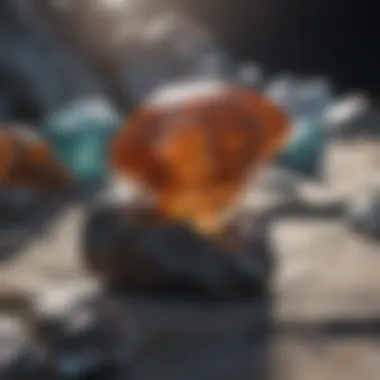Discovering Global Diamond Deposits and Mining


Intro
Diamonds have held a remarkable aura of fascination over centuries. These shimmering gems not only signify luxury and wealth but also encapsulate stories of their birth deep within the Earth. From the rough terrains of Africa to the icy landscapes of Siberia, the search for diamonds has shaped economies and cultures. In this exploration, the focus is on where these precious stones are found, the geological environments they inhabit, and the methods by which they are extracted.
This journey through diamond deposits goes beyond mere geography. It probes into the historical significance of each region and highlights the pressing ethical and environmental concerns tied to diamond sourcing in today’s world.
Gemstone Overview
Diamonds form a crucial part of the broader category we know as gemstones. These exquisite stones aren’t just pretty baubles; they possess distinct characteristics that make them fascinating both to collectors and to the scientifically inclined.
Definition and Characteristics
A diamond is essentially a crystalline form of carbon. Its unique structure contributes to its unmatched hardness; in fact, it's the hardest known natural material on the Mohs scale. This property not only enhances its desirability for jewelry but also for industrial applications. Other noteworthy characteristics include:
- Brilliance: The ability to refract light, creating a sparkling effect.
- Color: While a majority are colorless, diamonds come in a range of hues, including yellow, brown, and even the rarer blue or pink variants.
- Clarity: Refers to the presence of internal or external flaws; clearer stones are generally more valuable.
Classification of Gemstones
Gemstones can be classified into two main categories: precious and semi-precious. Traditionally, diamonds have been grouped into precious stones alongside sapphires, rubies, and emeralds.
However, the classification doesn’t stop there. Diamonds can further be categorized into:
- Natural Diamonds: Formed through natural processes over millions of years.
- Synthetic Diamonds: Created in laboratories, possessing similar properties to natural diamonds but differing in origin.
- Fancy Colored Diamonds: Diamonds that exhibit colors beyond the traditional colorless, prized for their rarity and unique appeal.
Understanding these classifications provides a better grasp of the various diamonds available in the market and enriches the appreciation of their individual beauty.
"Diamonds are not just a stone; they are moments of time captured in a gem."
Properties of Gemstones
Gyvent into gemstones further, it's essential to explore their properties comprehensively. These attributes significantly influence their desirability and value in both industrial and aesthetic contexts.
Physical Properties
Physical properties encompass aspects visible to the naked eye or obtainable through sensory means. For diamonds, these properties include:
- Hardness: As mentioned earlier, a diamond ranks a 10, making it an ideal candidate for tools in cutting and drilling.
- Luster: The stone’s surface reflects light, which can be described as adamantine in diamonds.
- Specific Gravity: Diamonds have a specific gravity between 3.1–3.5, contributing to their heft.
Chemical Properties
On a chemical level, diamonds are made exclusively of carbon atoms organized in a crystal lattice structure. This creates their unique hardness and contributes to several other properties:
- Inertness: Diamonds are resistant to most acids, making them stable in various conditions.
- Thermal Conductivity: Interestingly, diamonds excel in conducting heat, even better than metals.
These properties not only add to the allure of diamonds but also showcase their utility in various industrial applications, beyond merely serving as symbols of love and prestige.
In the coming sections, this article will delve deeper into the geological settings of diamond deposits, laying bare the intricate dance of nature that leads to the formation of these awe-inspiring gems.
The Global Landscape of Diamond Mining
The diamond mining sector is a global mammoth that plays a pivotal role in both the economies and cultures of the countries involved. It's not merely about the gems; it encompasses the labor, the communities, and even the environmental considerations tied to extracting these precious stones. Understanding the landscape is important because it reveals the intertwined nature of geology, politics, and ethical sourcing. Knowing where diamonds come from is more than trivia for enthusiasts or collectors; it informs responsible decisions regarding purchases and conservation efforts.
In our examination of the global diamond arena, we will explore significant diamond-producing regions, delving deep into the nuances of each locale's geological characteristics, socio-economic impact, and the mining techniques employed. This discourse not only highlights the labor that goes into diamond mining but also underscores the importance of ethical sourcing in an industry often shadowed by controversy.
Prolusion to Diamond Formation
Diamonds begin their existence deep within the Earth, where immense pressure and temperatures exceed 1,000 degrees Celsius. Formed over the course of millions of years, diamonds crystallize in a unique structure that gives them their brilliance and hardness. The process starts in what's known as the mantle, a layer above the Earth's core where carbon atoms bond in a tetrahedral shape under extreme conditions.
The journey of a diamond does not end with its formation beneath the Earth's surface. Through geological processes like volcanic eruptions, these beautiful stones are transported to the surface. They emerge primarily through kimberlite pipes—tubular formations created by volcanic activity. So, when one thinks of diamonds, it isn't just about the stones themselves but the journey they take to reach us.
Geological Conditions Favorable for Diamonds
To find diamonds, one must first understand the geological conditions that favor their formation and discovery. Here are some key elements that create ideal circumstances:
- High Pressure and Temperature: Diamonds form under conditions found around 160 kilometers deep in the Earth's mantle. Any significant deviation from this pressure-temperature equilibrium might result in non-diamonds.
- Kimberlite Pipes: These are the most prolific sources of natural diamonds. Formed by volcanic eruptions, kimberlite pipes carry diamonds from the mantle to the surface. They serve as the primary exploration targets for mining companies.
- Alluvial Deposits: Diamonds can also be found in riverbeds and shorelines, where they've weathered away from their original kimberlite sources and settled. These deposits are usually easier and less costly to mine, making them a significant part of the diamond market.
Understanding these geological aspects not only highlights the complexity behind diamond formation but also sheds light on why certain regions are more fruitful than others in diamond deposits. The confluence of geological science and economic incentives drives exploration efforts, reinforcing the need for responsible mining and ethical sourcing of diamonds.
Major Diamond-Producing Countries
Understanding the landscape of diamond production is crucial for anyone intrigued by gemstones. These major diamond-producing countries contribute significantly to the global supply and hold various historical and economic importance. Each country has its unique geological conditions, mining techniques, and ethical practices surrounding diamond extraction. By exploring these nations, readers gain insight into how diamonds are not just pretty stones but articles shaped by culture, economy, and environment.
South Africa: The Cradle of Diamonds
South Africa is often termed the Cradle of Diamonds due to its pivotal role in the history of diamond mining. The discovery of diamonds in the 1860s sparked a massive influx of fortune seekers, fundamentally changing the area's social and economic structures. Locations like the Kimberley Mine, famously known as the 'Big Hole', opened up a new era. Over the years, South Africa has produced some of the world's most notable gems, including the Cullinan Diamond, which now sits in the British Crown Jewels.
The current mining operations in South Africa reflect a blend of modern technology and traditional methods. De Beers, a name synonymous with diamonds, continues to operate here, using ethical practices that have advanced in recent years.


Botswana: A Beacon of Diamond Wealth
Botswana stands tall as a notable success story in diamond production. Following independence in the late 1960s, the country's partnership with De Beers transformed it into one of the world's leading diamond producers. The Jwaneng Mine is often termed the richest diamond mine in the world, in terms of value produced per tonne, showcasing the immense wealth embedded in the earth's crust of the region.
The revenue generated from diamonds has significantly improved the economy and infrastructure of Botswana, turning it into a beacon of wealth and stability in Africa. This country's approach not only emphasizes extraction but also advocates for sustainable development and community benefits.
Russia: The Cold Land of Hidden Treasures
Russia is a heavyweight in the diamond industry, with its vast and often inhospitable wilderness hiding considerable deposits. The Yakutia region is home to major operations like the Mirny Mine, which is famed for its size and depth. Interestingly, in extreme conditions, diamonds were discovered to have formed due to volcanic activity caused by ancient eruptions. Today, Russia produces over a quarter of the world’s diamonds.
The Russian diamond industry operates under the state-owned company, Alrosa, which controls a significant market share. Ethical practices in mining here are complicated, with international scrutiny often aimed at ensuring transparency and sustainability in operations.
Canada: Emerging as a Premier Source
In the past few decades, Canada has emerged as a premier source of diamonds. The exploits began in the mid-1990s when significant deposits were located in the Northwest Territories. The Diavik and Ekati mines are notable for their quality and environmentally responsible practices.
Canadian diamonds are often marketed as ‘ethical’ due to the country’s stringent regulations surrounding mining and labor practices. This has opened a niche market for consumers who prioritize responsibility alongside aesthetics when selecting diamonds.
Australia: Historical Significance in the Diamond Market
Australia has a rich history in diamond mining, particularly notable with the now-closed Argyle Mine. Known for producing pink diamonds, Argyle's closure has significantly impacted global supplies and prices. The diamonds from this site were unique, and among connoisseurs, they became synonymous with rarity and value, making Australia a key player in the diamond trade.
Even post-closure, Australia’s legacy in diamonds remains potent, with other mining ventures indicating that while Argyle may have stopped operations, the spirit of diamond exploration in the country is far from over.
In summary, the major diamond-producing countries not only enrich the market with their deposits but also illustrate the intricate tapestry of human endeavor, natural resources, and ethical considerations surrounding diamonds. These nations contribute distinctive characteristics to the diamond trade, shaping consumer perceptions and practices worldwide.
"Diamonds are not just about sparkle; they reflect the deep stories of the earth and its people."
Mining Techniques: Unraveling the Process
Mining techniques are the backbone of the diamond extraction industry. Understanding these methods offers insights into the effectiveness and efficiency of diamond recovery operations. Different techniques suit various geographical and geological contexts, which explains the diversity of approaches seen in the diamond mining sector.
The process of extracting diamonds is not simply about the tools and machinery used. It’s about understanding the landscape, contemplating the benefits and drawbacks of each technique, and determining how best to balance profit with sustainability. A deeper appreciation for these methods can enhance the collector's experience, inform investment choices, and foster an awareness of environmental stewardship.
Open-Pit Mining: An Overview
Open-pit mining offers a straightforward solution to diamond extraction. It involves creating a large excavation in the ground, where layers of earth are removed to access the deposits below. This technique is especially productive in regions like South Africa and Botswana, where diamond deposits are located relatively close to the surface.
A few key aspects define open-pit mining:
- Accessibility: Open-pit operations provide easier access to diamond deposits compared to underground techniques.
- Equipment Efficiency: Large machinery, like trucks and shovels, can be employed to move significant amounts of material quickly.
- Cost-Effectiveness: Generally, it requires lower operational costs compared to underground mining.
However, there are notable considerations:
- Environmental Impact: The alteration of the surface landscape can have serious ecological consequences.
- Surface Water: This method may affect nearby water sources and ecosystems.
Underground Mining: A Complex Challenge
Deep underground mining comes into play when diamond deposits lie far beneath the surface. Techniques such as block caving or the more traditional shaft mining involve intricate, costly operations requiring significant expertise and safety measures. Countries, like Russia and Canada, often rely on underground mining due to the nature of their deposits.
Key points about underground mining include:
- Structural Stability: The integrity of the mine must be constantly monitored to ensure safety for miners.
- Technological Integration: Advanced technologies, like conveyor belts and drilling tools, are essential to achieve effective extraction.
- Higher Costs: While potentially yielding high-quality diamonds, the operational costs can be significantly greater than open-pit mining.
Through this complex process, miners often face unique challenges, such as ventilation issues and the need for specialized equipment.
Alluvial Mining: Nature’s Gift on Riverbanks
Alluvial mining harnesses the power of nature. Diamonds that have eroded from their source can be found in riverbeds, along coastlines, or in deltas. This technique often requires only simple tools—think shovels and pans—making it accessible for artisanal miners.
Characteristics of alluvial mining are:
- Simplicity: It doesn’t usually require heavy machinery, thus reducing initial investment.
- Local Knowledge: Successful alluvial miners often rely on hereditary knowledge of the land.
- Environmental Harmony: This method can be less invasive compared to heavy mining methods, provided it is conducted sustainably.
However, with freedom comes responsibility:
- Regulation Gaps: Artisanal or unregulated alluvial mining can lead to exploitation and ecological harm.
- Market Fluctuations: Alluvial mining may be influenced by market demand, altering the viability of operations.
All three mining techniques present unique advantages and challenges, all underpinned by the knowledge of geology and environmental management. As the extraction of diamonds continues, understanding these processes becomes vital not just for miners but for anyone involved in the diamond trade or collecting.
Ethical Sourcing of Diamonds
In the contemporary diamond industry, the ethical sourcing of diamonds has gained remarkable importance. This topic is particularly pertinent given the complex history surrounding diamond mining and trade, which has often been marred by conflicts, exploitation, and environmental degradation. Ethical sourcing is not merely a buzzword; it's a commitment to ensure that diamonds are mined, processed, and sold in a way that respects human rights and preserves the environment. The relevance of this subject lies in its ability to reshape perceptions about diamond purchasing, encouraging consumers to choose stones that contribute positively to communities rather than fund conflicts or exploit workers.
The benefits of ethical sourcing are manifold. Firstly, it promotes transparency in the supply chain, allowing consumers to understand the origins of their diamonds. Purchasing ethically sourced diamonds fosters local economies and supports fair labor practices. In essence, it highlights a shift toward responsibility in consumerism, aligning purchasing power with personal values. Such awareness can lead to a groundbreaking change in the market dynamics, compelling companies to adopt more sustainable practices.
The Kimberley Process: A Framework for Ethical Sourcing


The Kimberley Process Certification Scheme, established in 2003, serves as a pivotal framework addressing the issue of conflict diamonds, often referred to as blood diamonds. Under this initiative, participating countries must certify that the diamonds they export are conflict-free. This process intends to avert the trade of diamonds that fund violent conflicts, particularly in regions like Africa.
While the Kimberley Process has made strides in mitigating the flow of conflict diamonds, its effectiveness has come under scrutiny. Critics argue that the process has gaps that can be exploited, allowing tainted diamonds to enter the market under the guise of being ethically sourced.
"The Kimberley Process has provided a necessary structure for certification, yet challenges remain in its implementation and enforcement across borders."
- Transparency is crucial for the Kimberley Process to remain credible. Companies and consumers must engage with brands that are committed to genuinely ethical practices and continuously evaluate how their diamonds are sourced.
Challenges in Ensuring Ethical Practices
Despite the framework established by the Kimberley Process, the journey toward truly ethical diamond sourcing is riddled with obstacles. One of the most significant challenges stems from a lack of uniform standards, leading to variances in implementing ethical practices across different regions and businesses. The disparity allows some diamonds to slip through the cracks into markets labeled as conflict-free.
Moreover, ensuring that all players in the supply chain abide by ethical considerations can be daunting. From miners in remote areas to jewelry designers and retailers in affluent regions, comprehensive oversight is crucial yet often lacking due to the fragmented nature of the diamond market.
Additional considerations involve the environmental impact of mining methods. Not all ethical sourcing is created equal—mining operations might adhere to human rights standards while still causing ecological harm. This highlights the necessity for a dual approach that incorporates both social responsibility and environmental stewardship.
In summary, ethical sourcing of diamonds is an intricate tapestry that poses significant challenges but also unfolds opportunities for genuine change. It brings forth the necessity for continuous evaluation and vigilance from consumers and businesses alike, ensuring that the beauty of diamonds is matched by their moral integrity.
The Environmental Impact of Diamond Mining
Diamond mining, while economically significant, carries profound ecological consequences that merit attention. In this section, we will delve into how diamond extraction processes impact the environment. Examining these effects provides a more comprehensive understanding of the diamond industry and its responsibilities towards sustainable practices.
Ecological Footprint of Mining Activities
The ecological footprint of diamond mining is staggering. Each stage of the mining process—be it open-pit, underground, or alluvial—contributes to habitat destruction, soil degradation, and water contamination.
- Habitat Destruction: In many locations where mines are established, forests or other natural habitats are cleared. The impact is not just immediate; the long-term effects can disturb entire ecosystems. For instance, the Argyle Mine in Australia led to significant changes in local flora and fauna due to extensive land clearing.
- Water Usage and Pollution: Diamond mining requires vast amounts of water, which can deplete local water sources. Furthermore, when waste materials from the mining process enter nearby rivers or lakes, they can lead to serious pollution. A case in point involves several mines in Africa where runoff has severely affected local communities' access to clean water.
- Soil Erosion and Degradation: As land is stripped of vegetation, the soil becomes more susceptible to erosion. In some areas, this has led to desertification, losing valuable agricultural land and pushing local populations into precarious situations.
Tracking these impacts is critical, and addressing them should be at the forefront of mining operations. Transparency in reporting ecological footprints can help mitigate risks and enhance corporate responsibility.
Rehabilitation and Restoration: Mitigating Damage
To combat the negative aftermath of the diamond mining process, rehabilitation and restoration efforts are essential. These initiatives aim to restore ecosystems that have been disrupted by mining activities, anchoring the mining industry within a framework of environmental stewardship.
- Site Rehabilitation Plans: Many mining companies are mandated to create detailed rehabilitation plans before beginning operations. These plans outline how they will restore land to its original state—or as close as possible—after mining is finished.
- Native Species Replanting: Restoration efforts often include reintroducing native flora to ensure that the ecosystem can thrive post-mining. This practice helps revitalize habitats, providing homes for local wildlife and improving soil health.
- Community Engagement: Local communities often have valuable knowledge about their environment and should be part of rehabilitation initiatives. Their involvement can help ensure that restoration efforts are both culturally and ecologically sensitive.
The choice to rehabilitate is not just beneficial; it uplifts the entire community by enhancing biodiversity and promoting environmental health.
While diamond mining inevitably impacts the environment, the commitment to responsible mining practices has the potential to make a significant positive difference. By acknowledging the challenges and actively working to rehabilitate impacted areas, the diamond industry can align itself with broader environmental goals.
Distinctive Locations Known for Diamonds
In the world of diamonds, certain locations stand out not just for the quantity of stones they yield but also for their unique attributes and historical narratives. These locations have played crucial roles in shaping the diamond industry, offering a window into the geological processes that create these precious gems and the cultural significance they embody. Understanding these distinctive locations provides insight into why they are considered key players in the global diamond trade.
Their geological formations contribute to a rich tapestry of diamond lore. Moreover, the techniques used in extracting diamonds from these sites often reflect both the innovation and the challenges of the mining industry.
The Argyle Mine: A Case Study of Unique Production
The Argyle Mine, located in Western Australia, is perhaps best known for its pink and red diamonds, which have become symbols of rarity and allure. The mine commenced production in 1983 and quickly gained prestige as one of the largest diamond producers in the world. Its unique composition is attributed to its formation within a volcanic pipe, which is a rare geological occurrence.
During its operation, Argyle generated an estimated 90% of the world's pink diamonds, leading to high demand and soaring prices in the jewelry market. The mine's closure in 2020 marked the end of an era, yet its influence on diamond valuation continues strongly today, emphasizing the concept that color can vastly enhance a diamond's worth.
“The Argyle Mine remains a shining example of how location can transform diamonds from ordinary gemstones to extraordinary assets.”
Kimberley Mine: Historical Significance
The Kimberley Mine, also known as the "Big Hole," located in South Africa, is steeped in history. It not only signifies the origins of large-scale diamond mining but also reflects the socio-economic factors surrounding the diamond rush of the 19th century.
This site was the first to attract the interest of prospectors in the late 1800s, leading to significant population growth and development in the region. The mine itself is an open pit that was dug to around 240 meters deep, making it an engineering marvel for its time. Today, Kimberley's legacy is preserved as a tourist attraction, highlighting the interplay between natural resources, human ambition, and historical significance in the diamond trade.
Jwaneng Mine: The Richest Diamond Mine
Nestled in Botswana, the Jwaneng Mine holds the title of the richest diamond mine in the world, and it’s not merely by chance. Opened in 1982, it produces a significant amount of gem-quality diamonds renowned for their size and quality.
The mine's wealth is attributable to its exceptional geological conditions, where large kimberlite pipes have created an environment ideal for diamond formation. Its strategic operations also reflect careful planning and financial investment, ensuring that the mine continues to be productive and economically beneficial for Botswana. Jwaneng's contributions to the local economy and its community programs underscore the evolving role of diamond mining in modern society.
Siberian Mines: Extreme Conditions and Rare Finds
In the frigid expanse of Siberia, diamond mining operates under some of the toughest conditions imaginable. The Russian Federation dominates the production of diamonds, primarily through mines like the Mirny and Udachny. Here, the harsh climate presents formidable challenges, yet it is this environment that also yields some of the world's rarest diamonds.
Siberian diamonds are famed for their strength and clarity, derived from ancient geological formations. Moreover, as technology advances, these remote operations continue to unearth stones that some would only dream of adding to their collections. The juxtaposition of extreme conditions and bounty makes Siberian diamond mining a fascinating study of resilience and natural bounty.
How to Identify Quality Diamonds
Understanding how to identify quality diamonds is a critical facet for anyone engaged in the world of gemstones, whether you're a collector, a jewelry designer, or even just someone looking to purchase a priceless piece. Quality diamonds don't just dazzle the eye; they possess intrinsic characteristics that discern them from stones of lesser quality.
One of the main reasons for knowing how to evaluate diamonds properly lies in the significant investment they usually entail. A well-chosen diamond can be a source of joy and pride, while a poorly selected one can bring regret. The importance of gem quality extends beyond financial aspects, as it also reflects your knowledge and appreciation of these beautiful gems.


Understanding the Four Cs
When evaluating diamonds, the "Four Cs" serve as the foundation of quality assessment. These are Carat weight, Cut, Color, and Clarity. Each of these elements plays a significant role in determining the diamond's overall value and visual appeal.
- Carat Weight: This measures the size of the diamond. A higher carat usually equates to greater value, but correlation doesn’t mean causation—you may find smaller diamonds that are worth much more due to their quality in the other Cs.
- Cut: This refers not only to the diamond's shape but also the quality of how well the diamond has been cut. A well-cut diamond reflects light beautifully, creating a sparkle that can catch anyone’s eye.
- Color: Diamonds come in a variety of colors, but the most prized are those with very little color. The scale ranges from D (colorless) to Z (light yellow or brown).
- Clarity: This measures the presence of internal or external imperfections, known as inclusions or blemishes. The fewer the imperfections, the higher the clarity grade.
Understanding these Cs will deepen your appreciation and improve your judgment when it comes to selecting high-quality diamonds.
Evaluating Color, Clarity, Cut, and Carat Weight
The next step involves a detailed examination of each of the Four Cs, which should be assessed with careful consideration:
- Color: To evaluate color accurately, place the diamond against a white background and use appropriate lighting. Look for colorlessness and any undertones that may shift the diamond to a lower grade. For collectors, understanding subtle differences in color can be crucial in determining the true value of a stone.
- Clarity: Using a jeweler's loupe or microscope, scrutinize the diamond closely. Look for inclusions that may affect the diamond's allure, as these may significantly influence its market value. The absence of visible inclusions at 10x magnification indicates a high-quality diamond that is rare to find.
- Cut: The cut impacts how well the diamond sparkles and interacts with light. A poorly cut diamond, no matter how perfect its color and clarity, will likely not show its full potential. Inspect the facets, symmetry, and polish to grasp the cut's quality.
- Carat Weight: Although size matters, each carat size comes with its unique price point. Be mindful that two diamonds of the same carat weight can differ drastically in terms of beauty and value based on the other Cs.
"The best diamond is the one that lights up your soul and fits within your budget."
Evaluating a diamond properly requires attentive observation and a refined understanding of these parameters. When these components come together, they create not just a beautiful gemstone but a masterpiece that embodies nature’s artistry. Keeping these elements in mind while choosing diamonds will not only fortify your choices but also bolster your reputation as a discerning connoisseur.
Cultural Significance of Diamonds
Diamonds hold a place not only in the realm of geology and commerce but also in the cultural tapestries spun by societies around the globe. These gemstones weave narratives that reflect our values, aspirations, and identities. The cultural significance of diamonds transcends mere adornment; they embody power, wealth, and even intricate social norms.
Diamonds in History: Symbols of Power and Wealth
Historically, diamonds have served as more than just precious stones. They were often the ultimate expression of status. Kings and queens adorned their crowns with the finest diamonds, with some getting lost in tales of their mystical origins and unparalleled value. For instance, the Hope Diamond, famed for its captivating deep blue hue and storied past, has been linked to nobility and declared worthy of a royalty’s heart.
In numerous cultures, possessing diamonds equated to an elevation in societal status. They became markers of wealth, signaling not just financial means but also power. When Viscount Althorp, the ancestor of Princess Diana, gifted her an engagement ring embellished with a dazzling sapphire alongside diamond accents, it signified both love and royal elegance. Such historical context illustrates how diamonds shaped societal hierarchies.
"A diamond is forever. It signifies moments, transformations, and connections beyond time."
This phrase encapsulates the role diamonds played in monumental life events, from engagements to royal marriages, cementing their importance in our cultural storytelling.
Modern Symbolism: Love, Commitment, and Status
In contemporary society, diamonds have evolved into symbols of love and commitment. The popularization of diamond engagement rings can be traced back to an ingenious marketing campaign by the De Beers diamond company in the 20th century. Their slogan, "A diamond is forever," cemented the diamond’s place not just as a gift but as a lifelong commitment in a relationship. This change reflects how diamonds shifted from being merely prized possessions to being emblematic of emotional bonds.
Moreover, in today's culture, diamond jewelry is also tied to individual stature and social identity. People wear diamonds not just for personal adornment but also as expressions of their aspirations and lifestyle. Diamonds serve as signals of success,
- Prestige: Owning diamonds can symbolize achievement, representing not just financial capacity but also taste and discernment.
- Festivals and Celebrations: Different cultures integrate diamonds into their festivals, showcasing their beauty and significance.
Ultimately, while the geological journey of diamonds is fascinating, their cultural ramifications make them equally compelling. The significance embedded in precious diamonds mirrors the complexities of human emotion and societal values.
Future Trends in Diamond Exploration
The diamond industry is evolving, and keeping pace with changes is crucial for all involved. From gemstone enthusiasts to geologists, understanding the future trends in diamond exploration can prove beneficial. This section dives into notable developments shaping the industry and examines the skills needed for future exploration efforts.
Technological Advances in Mining
Innovations in technology are paving the way for more efficient diamond mining techniques. Projects that were once deemed too complex or not lucrative enough are now becoming viable. For instance, remote sensing technology allows mining companies to survey and locate deposits from afar. By utilizing satellite images and advanced geological software, companies can dramatically cut down on exploration time. As data analysis tools become more sophisticated, they help identify patterns in geological formations that may have been overlooked.
- Automation: Machines now do what was once manual labor, increasing safety and productivity on sites.
- 3D Modeling: Computer models can simulate geological conditions, allowing for better planning and risk assessment.
- Eco-friendly Approaches: Techniques that minimize environmental damage are on the rise. Companies are incorporating methods that allow them to respect natural habitats while continuing to extract valuable resources.
The Role of Synthetic Diamonds in the Market
Synthetic diamonds are shaking things up in the diamond market. Initially met with skepticism, these lab-grown gems have carved a niche that appeals to consumers. They are cheaper and often come with fewer ethical concerns. This segment is growing fast, and companies are adapting strategies to include synthetic diamonds in their portfolios.
Some points to consider include:
- Market Demand: More people are looking for alternatives to mined diamonds, which are viewed as more sustainable.
- Quality and Variety: The technology behind synthetic diamonds allows for a vast range of colors and qualities at competitive prices.
- Branding Challenges: Jewelers must strategize on how to position these synthetics against traditional diamonds to avoid consumer confusion.
The rise of synthetic diamonds underscores the shifting values of modern consumers, who increasingly prioritize sustainability over tradition.
Finale: The Intersection of Beauty and Ethics
As we wrap up our journey through the world of diamond deposits, it's crucial to ponder the harmony between the inherent beauty these stones carry and the ethical dilemmas they sometimes involve. The allure of diamonds has captivated humans for centuries, serving as symbols of love, power, and luxury. Yet, beneath this shimmering surface lies a web of complexities tied to their extraction and trade.
Acknowledging the Dual Narrative
On one side, we have the dazzling diamond, the star of engagements, a mainstay in the jewelry industry, celebrated for its brilliance and desirability. On the other side, there are pressing questions regarding the sourcing of these precious gems. The topic forces us to confront uncomfortable truths about conflict diamonds, environmental destruction, and the social implications of mining practices.
Ethics in the Diamond Trade
Efforts like the Kimberley Process aim to curb the trade of conflict diamonds by ensuring that stones reach the market in a way that doesn't fund violence. Despite these initiatives, gaps remain, and the challenge is ongoing. Many consumers are now looking beyond the sparkle and inquiring about the origins of their diamonds, leading to increased demand for ethically sourced gemstones.
Benefits of Ethical Practices
- Consumer Awareness: Shoppers nowadays want proof that their diamonds are ethically sourced. Transparency is key.
- Sustainability: Mindfully sourced diamonds align with environmental stewardship, promoting better practices in mining.
- Empowerment: Supporting local communities can be achieved through fair trade practices, ultimately enriching the economic fabric of diamond-producing regions.
"To wear a diamond is to display not just wealth, but the story of its journey from the ground to one’s hand."
Looking Ahead
As markets evolve, so does the perception of diamonds. New technologies are also paving the way for synthetic diamonds, which come without the associated ethical concerns tied to natural diamond mining. While this may reshape the industry, the physical and emotional connection to natural diamonds will likely linger.



